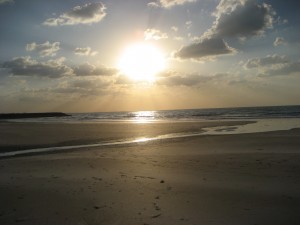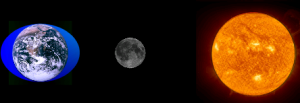 This weekend the moon pulled back the curtains on the beach, revealing plenty of sand in the evening hours. I love the beach in the winter, particularly near dusk. The sand seems to go on for miles; when there’s a full moon, it rises from behind the mountains, which are still rosy from alpenglow.
This weekend the moon pulled back the curtains on the beach, revealing plenty of sand in the evening hours. I love the beach in the winter, particularly near dusk. The sand seems to go on for miles; when there’s a full moon, it rises from behind the mountains, which are still rosy from alpenglow.
I think I understand how tidal extremes work, enough so that I can explain using a stick drawing in the sand. The moon and the Sun and the Earth fall into line (or close enough), giving a little extra tug on the tides. These higher highs and lower lows are called spring tides, ones that “spring forth” around the time of the new and full moons.
But I haven’t yet figured out why the beach seems to appear mostly in the evening in the wintertime, while it’s drowning in seawater near dawn. I might not have noticed this was happening at all, except that the first year we moved here, a fellow dog walker clued us in. “It’s winter time,” he said, as we headed toward the ocean. “The beach will be covered.” He pointed us to the grassy fields at the community college.
 Why do the highest tides in winter tend to fall in the morning, making it tricky to walk dogs and too swamped to surf before the kids wake up? The truth is, I was planning on figuring that out in this post, but I’m not sure that I can. I’ve read that in winter, the higher high and higher low tides are in the morning—which could make it seem like the tide is always “high” in the morning. But I still don’t know why that is.
Why do the highest tides in winter tend to fall in the morning, making it tricky to walk dogs and too swamped to surf before the kids wake up? The truth is, I was planning on figuring that out in this post, but I’m not sure that I can. I’ve read that in winter, the higher high and higher low tides are in the morning—which could make it seem like the tide is always “high” in the morning. But I still don’t know why that is.
These are the clues I have so far (some may be red herrings):
- The Earth is at perihelion, or closest in its orbit to the sun, around January 3.
- I am in the Northern Hemisphere, where the Earth’s axis is tilted away from the sun in winter.
- We have semidiurnal mixed tides—so two highs and two lows each day, with the highs and lows of different sizes.
- Events seem to conspire to prevent me from surfing. Take today: decent northwest swell coming in, and me with a head cold.
I have found some basic explanations online, but trying to sort them out makes me want to crawl into bed, and I already am. So if any would-be Sherlock (or Watson) is so inclined (not declined—could this be another clue?), I’d be most grateful if you’d post the explanation in the comments.
The reward: an animation of how it works, sometime in 2014, including a special tribute to the sleuths.
**
Images from Wikimedia Commons contributors Iardo and Theresa Knott
Holmes won’t be of any help. According to Dr. Watson’s inventory of his new room-mate:
“Knowledge of astronomy: Nil.”
And in his own words: “What the deuce is it to me?” he interrupted impatiently: “you say that we go round the sun. If we went round the moon it would not make a pennyworth of difference to me or to my work.”
My dear Cameron, I’m flattered by your interest, but I consider myself married to my work.
And it is of the highest importance not to have useless facts elbowing out the useful ones.
— SH
The ocean sloshes, and as it sloshes the Coriolis effect comes into play. (See http://www.gly.uga.edu/railsback/Tides/TidesMain.html .) Hence, only a few places have high tides exactly at lunar zenith and nadir; most have their tides arrive at a specific offset before or after those times. And the differences are gross: the high tides on 2013 Jan 1 were at 0230 and 1323 at the San Francisco Golden Gate, but were at 0746 and 1851 at Seattle. (Tide tables: SF: http://wolfweb.unr.edu/homepage/edc/tides/2013/sfgg_fr13.html ; Seattle http://usharbors.com/monthly-tides/Washington-Puget%20Sound/Seattle/2013-01 . On that day, the Moon set at 0942, and rose again at 2129; nadir would have been around 1535. http://aa.usno.navy.mil/data/docs/mrst.php )
You’re going to have to find a tide table for near where you live to get a good feeling for when the tides are hitting, really.